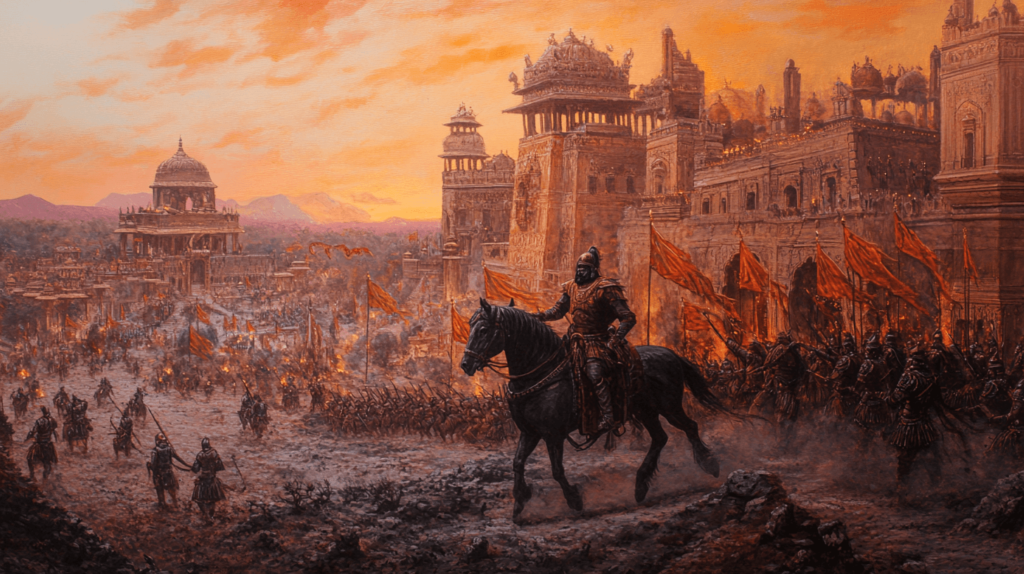
The Gupta Empire, often referred to as the Golden Age of Ancient India, was a period of unprecedented cultural, scientific, and artistic achievements. However, this glorious era came to a dramatic end with the invasion of the Huns, also known as Hunas in Indian sources. This article explores the fascinating story of how these nomadic warriors from Central Asia, who had already a brought down one of the most powerful empires in Indian history, plunging much of the subcontinent into a state of anarchy.

The Rise and Glory of the Gupta Empire
Before delving into the Hun invasions, it’s essential to understand the empire they sought to conquer. The Gupta Empire, established around 320 CE by Chandragupta I, reached its zenith under the rule of Chandragupta II (380-415 CE). During this period, India experienced remarkable advancements in various fields:
Scientific Achievements: The Gupta era saw significant progress in mathematics and astronomy. The concept of zero was developed, and the decimal system was refined.
Artistic Flourishing: Literature, sculpture, and painting thrived. The famous Ajanta and Ellora caves were embellished during this period.
Economic Prosperity: Trade relations with Rome, Southeast Asia, and China brought immense wealth to the empire.
Political Stability: The Guptas maintained a vast territory through a combination of military might and strategic alliances.
This golden age seemed unshakeable, but external forces were gathering strength beyond the empire’s northwestern frontiers.

The Huns: Nomadic Warriors from the Steppes
The Huns, originally from the Central Asian steppes, were a confederation of nomadic tribes known for their exceptional horseback riding and archery skills. They had already made their mark in Europe, where their invasions contributed to the fall of the Western Roman Empire.
The Huns were likely of Turkic or Mongolic origin, with a lifestyle centered around horse-riding and warfare. Their hit-and-run tactics and composite bows made them formidable opponents on the battlefield. The Huns were driven by a combination of factors, including the search for new pastures, the lure of wealthy civilizations, and internal power dynamics.

The First Hun Invasion: Testing the Waters
The first major Hun invasion of India occurred in 458 CE (just six years after the western Huns under Attilla attacked Italy), during the reign of Skandagupta, son of Kumaragupta I. This initial incursion was more of a probing attack than a full-scale invasion.
The Huns, having defeated the Kushanas, entered the subcontinent through the Kabul valley in what is now Afghanistan. They managed to penetrate into Punjab and parts of the Gangetic valley, exploiting weaknesses in the Gupta Empire’s northeastern frontier.
Skandagupta, proving himself a capable military leader, successfully repelled this first wave of Hun invaders, but while the Gupta Empire emerged victorious, this invasion exposed vulnerabilities in their defenses and hinted at the challenges to come.

The Second Hun Invasion: The Empire Crumbles
The Huns, under the leadership of Toramana, bided their time until 470 CE, shortly after the death of Skandagupta. This second invasion would prove far more devastating.
The Huns strategically waited for a moment of transition in Gupta leadership to launch their attack. This time, Toramana’s forces managed to conquer vast swathes of northern India, including Jammu, Kashmir, Himachal, Rajasthan, Punjab, and parts of Malwa.
Unable to mount an effective defense, the Gupta Empire’s control over these regions crumbled. Toramana established a Hun kingdom across vast areas of Northern India, marking a significant shift in the subcontinent’s political landscape

Mihirakula: The “Indian Attila”
Following Toramana’s success, his son Mihirakula (also known as Mihirgula) took control of the Hun forces in India. Mihirakula inherited a vast territory and continued his father’s expansionist policies with even greater ferocity. His reign would leave an indelible mark on Indian history: Mihirakula became known for his cruelty and destructive tendencies, earning him the moniker “Indian Attila”. Under Mihirakula, the Huns temporarily overthrew the Gupta Empire, ruling from their capital at Sakala (modern Sialkot).

Mihirakula’s reign saw widespread destruction of Buddhist monasteries and persecution of Buddhists. While major urban centers, including the former Gupta capital of Pataliputra, were reduced to ruins.
Defeat of Mihirakula
As Mihirakula’s atrocities mounted, Indian rulers began to recognize the existential threat posed by the Hun invader. A confederation of Indian rulers, led by Yashodharman of Malwa and supported by the Gupta Emperor Narasimhagupta Baladitya, began to form a united front against the Huns. This confederation of Indian rulers decisively defeated the Hunnic armies at Sondani in 528 CE, resulting in the loss of Hun possessions in the Punjab and north India over the next 14 years.

Sondani effectively ended the Hunnish threat in India, forcing them to retreat to the northwestern frontiers and eventually back to Central Asia. It allowed for the resurgence of numerous smaller kingdoms across northern India, filling the power vacuum left by the declining Gupta Empire. With the end of Mihirakula’s persecution, Buddhism in Northwestern India saw a brief period of revival before facing new challenges in subsequent centuries.






My favourite subject in school was History. After so long I am reading Guptha’s story. Love this article.